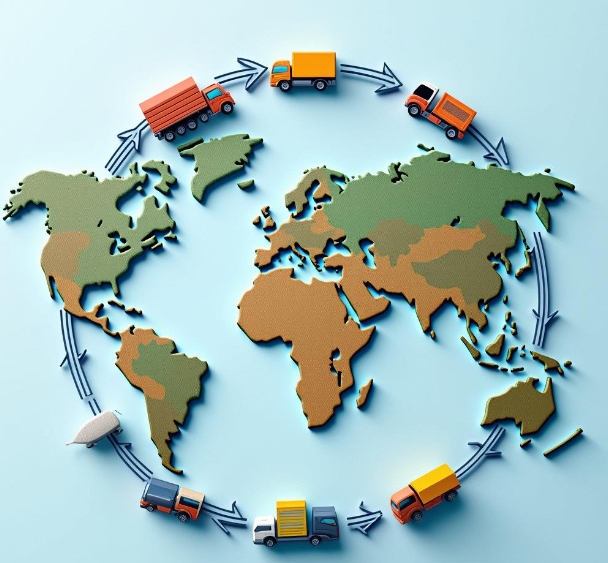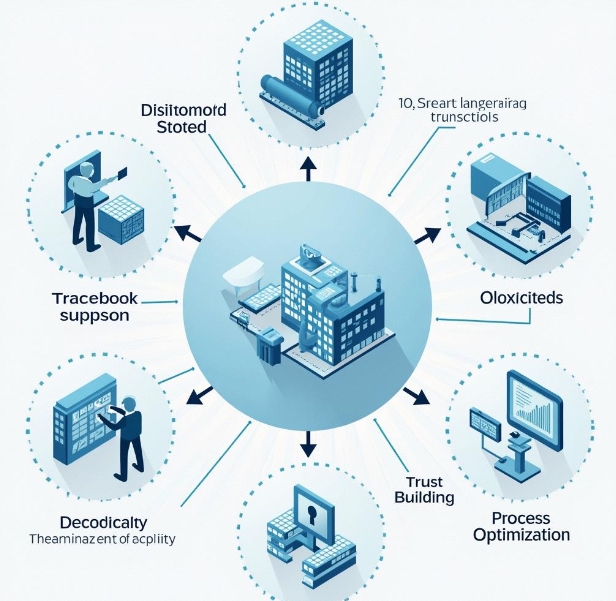Trade Industry Application Development Solutions
- latest articles
- 1.DApp Development & Customization: Merging Diverse Market Needs with User Experience 2.Analysis of the Core Technical System in DApp Project Development 3.How to achieve cross-chain interoperability in Web3 projects? 4.How does the tokenization of points reconstruct the e-commerce ecosystem? 5.How to Set and Track Data Metrics for a Points Mall? 6.What is DApp Development? Core Concepts and Technical Analysis 7.Inventory of commonly used Web3 development tools and usage tips 8.Development of a Distribution System Integrated with Social E-commerce 9.Six Key Steps for Businesses to Build a Points Mall System 10.What is DApp Development? A Comprehensive Guide from Concept to Implementation
- Popular Articles
- 1.Future Trends and Technology Predictions for APP Development in 2025 2.Analysis of the DeFi Ecosystem: How Developers Can Participate in Decentralized Finance Innovation 3.From Zero to One: How PI Mall Revolutionizes the Traditional E-commerce Model 4.DAPP Development | Best Practices for Professional Customization and Rapid Launch 5.Recommended by the Web3 developer community: the most noteworthy forums and resources 6.From Cloud Computing to Computing Power Leasing: Building a Flexible and Scalable Computing Resource Platform 7.How to Develop a Successful Douyin Mini Program: Technical Architecture and Best Practices 8.Shared Bike System APP: The Convenient Choice in the Era of Smart Travel 9.How to Create a Successful Dating App: From Needs Analysis to User Experience Design 10.From Design to Development: The Complete Process of Bringing an APP Idea to Life
With the advancement of global economic integration, international trade has become a vital component of economic cooperation between nations. In this context, the development of the trade industry faces numerous new challenges and opportunities. To enhance trade efficiency, optimize resource allocation, and strengthen supply chain management, an increasing number of trading companies are relying on information technology, particularly application development, to improve their operational models.
This article will delve into application development solutions in the trade industry, covering their importance, challenges, key technologies, and future development trends, helping industry enterprises better understand how to enhance competitiveness through technological innovation.
I. Major Challenges Facing the Trade Industry
1. Cross-Border Payments and Exchange Rate Risk Management Trading companies often face issues such as diverse payment channels and significant exchange rate fluctuations when conducting cross-border transactions. Ensuring payment security, reducing exchange rate risks, and improving capital flow efficiency have become critical to business development.
2. Complexity of Supply Chain Management Supply chains in international trade often involve suppliers, logistics companies, and intermediaries across multiple countries and regions. The cross-border transaction process is complex, and coordination among information flow, capital flow, and goods flow is often inefficient, leading to delays, losses, and even fraud.
3. Compliance and Legal Risks Trade policies and legal regulations vary significantly across countries. Ensuring that trade activities comply with legal requirements and reducing legal risks have become unavoidable challenges in global trade.
4. Asymmetry of Market Information In the ever-changing international market environment, trading companies often face the challenge of asymmetric market information. Timely access to market demand, price fluctuations, and competitive dynamics, along with accurate decision-making, can give companies a competitive edge.
5. Insufficient Data Management and Analytical Capabilities Trade activities generate vast amounts of transaction data, logistics data, and customer data. However, effectively managing and analyzing this data to extract valuable insights and improve decision-making efficiency and accuracy remains a pressing issue for many enterprises.

II. The Necessity of Application Development Solutions
With the continuous advancement of technology, especially the application of emerging technologies such as big data, cloud computing, artificial intelligence, and blockchain, the digital transformation of the trade industry has become an inevitable trend. Through application development solutions, enterprises can:
1. Enhance Operational Efficiency By developing automated management systems, manual operations can be reduced, improving efficiency in order processing, inventory management, payment settlement, and other areas, shortening transaction cycles, and lowering human error rates.
2. Optimize Supply Chain Management Using intelligent supply chain management platforms enables real-time tracking of goods logistics, monitoring progress at each stage, and identifying potential issues in advance for adjustments. Data-driven decision support helps optimize resource allocation, reduce inventory costs, and enhance supply chain flexibility.
3. Strengthen Data Security and Compliance Management Modern application development enables strict compliance management, automatically generating reports and data that adhere to various national regulations. Technologies like blockchain ensure the security and transparency of transaction data, reducing the risk of fraud and information leakage.
4. Enable Intelligent Decision Support By integrating artificial intelligence and machine learning algorithms, application systems can extract trends and predict market demands from vast amounts of data, helping enterprises make precise decisions in complex market environments.
5. Provide Personalized Customer Service Application development can deliver Customer Relationship Management (CRM) systems that use customer data analysis to offer personalized recommendations and services, thereby enhancing customer satisfaction and loyalty and strengthening market competitiveness.
III. Key Technologies for Application Development in the Trade Industry
1. Big Data Technology The trade industry generates massive amounts of data daily, including customer information, transaction records, supply chain information, and market dynamics. Big data technology enables effective storage, processing, and analysis of this data to uncover its value. Data analysis helps enterprises understand market trends, forecast demand, optimize inventory management, and reduce logistics costs.
2. Cloud Computing Cloud computing provides the trade industry with efficient, low-cost computing and storage services. Through cloud platforms, enterprises can achieve data sharing and collaborative work, access system resources anytime and anywhere, and flexibly scale their business operations. Cloud computing also reduces reliance on local IT infrastructure, lowering operational costs.
3. Blockchain Technology Blockchain technology offers reliable solutions for cross-border payments, supply chain traceability, and contract management. Its decentralized and immutable nature ensures transparency and security in transactions, reducing fraud risks and enhancing trust. In the trade industry, blockchain can record detailed transaction information and automatically execute contract terms via smart contracts.
4. Artificial Intelligence and Machine Learning Artificial Intelligence (AI) and Machine Learning (ML) play significant roles across various aspects of the trade industry. AI can analyze vast amounts of market data, predict market demand, and optimize pricing strategies to enhance competitiveness. ML can forecast logistics conditions and customer needs based on historical data, providing a scientific basis for enterprise decisions.
5. Internet of Things (IoT) IoT technology uses smart sensors and devices to transmit real-time data from logistics, inventory, and warehousing to system platforms, providing precise data support for supply chain management. IoT helps trading companies monitor inventory in real time, ensure timely delivery of goods, and improve the responsiveness of the entire supply chain.

IV. Implementation Steps for Application Development Solutions in the Trade Industry
1. Requirement Analysis and Goal Setting Before developing any application, it is essential to clarify the enterprise's specific needs and objectives. This includes identifying business pain points, technical requirements, and budget constraints. Communication with business departments ensures that application development accurately addresses existing issues and enhances operational efficiency.
2. Technology Selection and System Architecture Design Based on the requirement analysis, select appropriate technology stacks and platforms. For example, cloud computing platforms can provide efficient data storage and processing capabilities, blockchain can ensure data security, and AI can improve decision-making accuracy. System architecture design must consider scalability, security, and high availability.
3. Application Development and System Integration With technology selection and system architecture in place, proceed with application development. This process includes front-end and back-end development, database design, and integration of third-party interfaces. System integration is crucial to ensure seamless connectivity between the new application and existing systems and processes.
4. Testing and Optimization After development, conduct comprehensive testing to ensure the system operates stably in real-world use, addressing potential bugs and performance bottlenecks. Continuously optimize the system based on user feedback and data analysis to enhance user experience and system performance.
5. Deployment and Maintenance After successful testing, deploy and launch the system. Post-launch, perform regular maintenance and updates to ensure continuous optimization as the business evolves and technology advances. Adjust system functions according to market changes and enterprise needs to ensure long-term applicability.
V. Future Trends in Application Development for the Trade Industry
1. Intelligence and Automation With the continuous advancement of AI and ML, the trade industry will increasingly rely on intelligent and automated solutions. For example, smart warehousing, automated sorting, and logistics distribution will gradually replace traditional manual operations, improving efficiency and reducing costs.
2. Blockchain and Cross-Border Payments Blockchain is playing an increasingly important role in global trade. Through blockchain technology, secure and transparent cross-border payments and settlements can be achieved, eliminating trust barriers in payments and providing more efficient and reliable payment solutions for global trade.
3. Omnichannel Supply Chains With the rapid development of e-commerce, cross-border e-commerce is becoming a new trend in trade. Building omnichannel supply chains will be a key direction for enterprise digital transformation. Through multi-channel sales platforms and end-to-end digital management, enterprises can achieve rapid response and precise operations in cross-border e-commerce.
4. Data-Driven Decision-Making Data will continue to be a critical resource for enterprise competitiveness. By combining big data analytics and AI, trading enterprises can more accurately grasp market dynamics, predict consumer demand, and make more scientific decisions.
VI. Conclusion
Application development has become a vital tool for enhancing competitiveness and achieving digital transformation in the trade industry. Through technologies such as big data, cloud computing, and blockchain, enterprises can make significant progress in improving operational efficiency, optimizing supply chain management, reducing risks, and enhancing customer service. In the future, as technology continues to advance, application development solutions in the trade industry will become more intelligent, automated, and precise, further driving the efficient development of global trade.
-

How to Use App Development to Boost Conversion Rates on E-commerce Platforms
With the widespread adoption of smartphones and the rapid development of mobile ···
-

How APP Development Facilitates Digital Transformation and Innovation
With the rapid advancement of information technology, digital transformation has···
-

App Store Optimization and SEO Strategies in App Development
In today's rapidly evolving mobile internet landscape, apps have become essentia···

 Blockchain
Blockchain










